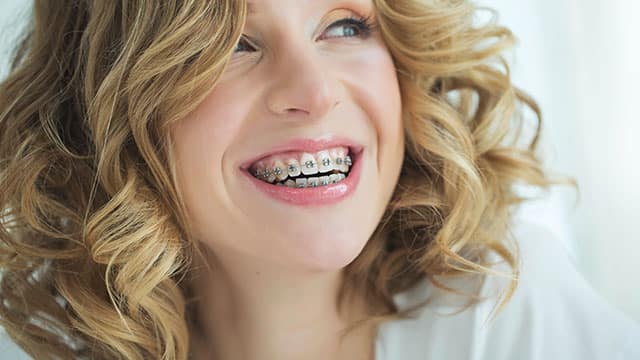Parts of Braces
Most braces have four parts. Here’s each one and its role in aligning your teeth:
- Brackets – the small, square metal pieces attached to the front outer surfaces of the teeth
- Archwire – connects the brackets to one another and controls the tooth movement
- Metal bands – placed on the back teeth
- Interarch rubber bands or elastic ties – secure the wires to the brackets
How Do Braces Work?
The American Association of Orthodontics (AAO) explains that braces work by having the brackets slowly and deliberately applying force to your teeth. Your orthodontist will tighten the archwire in order to continue to add pressure to your teeth. That pressure on your teeth can lead to minor discomfort.
This ongoing pressure slowly repositions your teeth, moving them into the correct alignment.
If your teeth require more force, your orthodontist may give you small rubber bands to temporarily connect the teeth in your upper and lower jaws using hooks on the brackets. This is done to reposition the jaws and correct the bite.
Why Do Rubber Bands on Braces Hurt So Much?
Consider this analogy between the rubber bands and lifting weights. As you continue your weight-lifting workout, your muscles become conditioned and strengthened and your muscle soreness starts to diminish. Rubber bands are like additional weights. They produce more pressure to correct your tooth and jaw alignment. And like your muscles adjusting to added weight, the discomfort from the rubber bands should subside in 2-3 days.
The American Association of Orthodontics (AAO) explains another way the rubber bands can be bothersome. The rubber bands – or even parts of the braces – may rub the inside of your cheeks, causing sore spots.
Pain is one common reason patients don't continually wear their rubber bands as directed. However, following your orthodontist's instructions is critical to achieving your goal of a straight smile.
How To Relieve Pain From Braces
There are several at-home techniques for managing the pain from your braces:
- To alleviate pain caused by parts of the brackets, bands, or wires rubbing the inside of your cheeks, try placing orthodontic wax on the braces' hardware
- Try taking an over-the-counter pain medication such as acetaminophen
- Try applying a topical anesthetic to provide temporary relief
- According to the American Dental Association, rinsing with warm salt water may also help to soothe any canker sores that develop from braces
You can also ask your orthodontist for tips on managing discomfort as your treatment plan continues.
Experiencing moments of minor pain is a normal part of the teeth-straightening process. After all, your teeth are moving and shifting into a better position, all in order to give you a beautifully straight smile. So when some discomfort rears its head, just remember: The minor and manageable pain will be worth it!
Oral Care Center articles are reviewed by an oral health medical professional. This information is for educational purposes only. This content is not intended to be a substitute for professional medical advice, diagnosis or treatment. Always seek the advice of your dentist, physician or other qualified healthcare provider.
ORAL HEALTH QUIZ
What's behind your smile?
Take our Oral Health assessment to get the most from your oral care routine
ORAL HEALTH QUIZ
What's behind your smile?
Take our Oral Health assessment to get the most from your oral care routine















